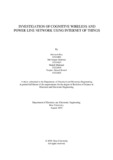Investigation of cognitive wireless and power line network using internet of things
Abstract
Now a days, smart grid is getting more popularity than the electric power grid because of its two-way communication between consumers and utilities. Using internet of things (IoT), smart grid is monitoring the both way communication which is one of the major tasks of smart grid. So, in this thesis, we observed the cognitive wireless and power line network using IoT. To do that, we have set-up a system model consisting of transmitter, receiver, and different relays. Besides, we have formulated equations for signal to noise ratio for relay network, cumulative distribution function (CDF) and probability density function (PDF). Likewise, we have analyzed the spectrum sensing of cognitive radio, throughput of wireless channel and the path loss model. In addition, we have also derived the equations of the throughput for cognitive wireless channel with and without the interference. Finally, from all the equations and data, numerical results that the efficiency increases for both wireless and power line communication. The efficiency increases with the increase of path loss exponent, transmission power, distance of transmitter and receiver for wireless networks. On the other hand, the capacity improves significantly with the increase of signal to noise ratio (SNR) and transmission power of secondary user for power line communication (PLC).

